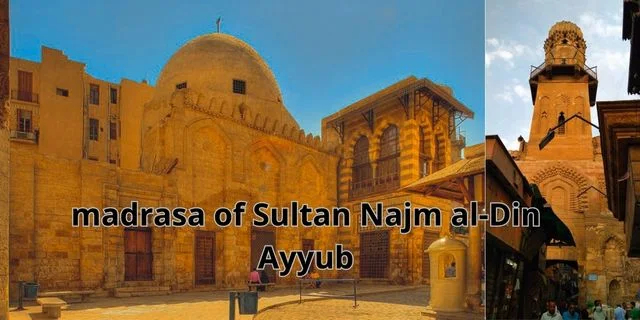The madrasa of sultan al-salih Najm al-Din Ayyub at cairo
One of the most important architectural structures remaining from the Ayyubid period, it is located in the Bayn al-Qasrayn area of Al-Muizz li-Din Allah Street.

It was known as the Al-Salihiya School, as Sultan Al-Malik Al-Salih Najm Al-Din Ayyub began to establish it in the year 641 AH / 1243 AD. This school is the first of its kind to teach the Sunni sects in Egypt, as it was established to teach the four schools of jurisprudence instead of the Shiite sect that was taught by the Fatimids before, and each sect had a special place inside the madrasa.
Sultan Al-Saleh Najm Al-Din Mosque - Al-Salihiya School 641 AH corresponding to 1243-1244 AD. This school was established by the righteous Najm al-Din Ayyub, the seventh of the ruler of the king of Egypt, one of the sultans of the Ayyubid state.
Thus, the al-Salih Najm al-Din Ayoub is considered the first to decide to teach jurisprudence according to the four schools of thought in one school in Egypt, according to what was stated in “The Shura Councils in the Age of the Mamluk Sultans” by Othman Ali Atta, where he made a lesson for each school of thought in the year 641 AH Thus, he is considered the first to work in Egypt,Four doctrines somewhere, as Al-Maqrizi said.
Who is Sultan al-Salih Najm al-Din Ayyub?
He is the good sultan, King Najm al-Din Ayyub, son of Sultan al-Malik al-Kamil Nasir al-Din Muhammad, son of Sultan al-Malik al-Adil Saif al-Din Abi Bakr, son of Emir Najm al-Din Ayyub bin Shadi al-Ayyubi, Sultan of Egypt. He is Sultan Al-Saleh Najm Al-Din, son of Sultan Al-Malik Al-Kamil Muhammad bin Al-Sultan, Al-Malik Al-Adil Abi Bakr Muhammad bin Ayyub; He was born in the year 603 AH in Cairo.
They said about him "al-Salih was a majestic and mighty king with power and majesty, and he was eloquent, well-spoken, and chaste for immorality."
"He was majestic, high-spirited, chaste, pure of tongue and tail, very dignified, a lot of silence, and gathered from the Turkic Mamluks what he did not gather for other than his family, until he was the most military prince of his mamluks."
The facade of the madrasa :
The main façade of the school was built of polished stones stacked very carefully. The façade of the madrasa is now hidden by the shops. It is divided into three main parts: the middle part, which includes the entrance and its sides, and is 18 meters long; the right part, 31 m long, The left part has a length of 26 m.
The height of the middle part is 12 meters, while the right and left parts are about 11.50 meters high. The middle part (entrance) includes a horizontal inscription band inscribed in Naskh script(foundation inscription) bearing the name of the creator and a supplication for him. In the middle of this part is the opening of the door, which is surmounted by a lintel consisting of interlocking cymbals. The entrance is crowned by a vaulted apse decorated with five rows of stalactites.
The minaret of madrasa is the only one of the Ayyubid period to have survived. It has a rectangular base decorated with keel-arched panels with fluted hoods of stucco. The upper level is an octagonal section decorated with lobed openings and stalactites which carry the ribbed helmet or mabkhara.
The interior:
The madrasa of Al-Salih Najm Al-Din Ayoub consists of “two main parts separated by a corridor and above the entrance the minaret, and each part consists of two opposite iwans (the iwan is a roofed hall with only three walls, and the fourth side is completely open to the open air, or it may be lined with columns, or it is preceded by an open gallery overlooking the The courtyard or the inner courtyard), between them is a courtyard and attached to the school is a mausoleum next to the western iwan, and above it is a dome of bricks and the walls of the mausoleum are made of stone and a garden that transforms the dome from square to circle in which three rows of stalactites were used - from the elements of Islamic architecture, and it resembles a single muqarnas if it is taken separated from its group a small mihrab, or a longitudinal part of it, and its walls were covered from the inside with colored marble.
The mausoleum:
The mausoleum of al-Salih Najm al-Din is located in the northeast of the Maliki iwan of the al-Salihiyya school. Its façade contains two apse, one of which is prominent. There is molding decoration. The entire façade is decorated until the beginning of the madrasa. It is similar to that of the al-Aqmar mosque. Listed and the height up to the verandas is more than 11 meters. After the death of Al Salih Ayyub his widow married al-Muc izz Aybak and managed to rule Egypt. She built a mausoleum for her dead husband, which was attached to his madrasa.
The entrance to the shrine is surmounted by a lintel with strangely shaped interlocking castanets, and above that is a panel with four lines of naskh writing, and on both sides of the entrance are two recessed areas in the form of seas. Ornate surrounds the door on all sides. The mausoleum is almost square, with a side length of more than 10 meters, but it is in an inclined position so that they get the correct angle of the mihrab, which is the southeastern side.
What's Your Reaction?




















